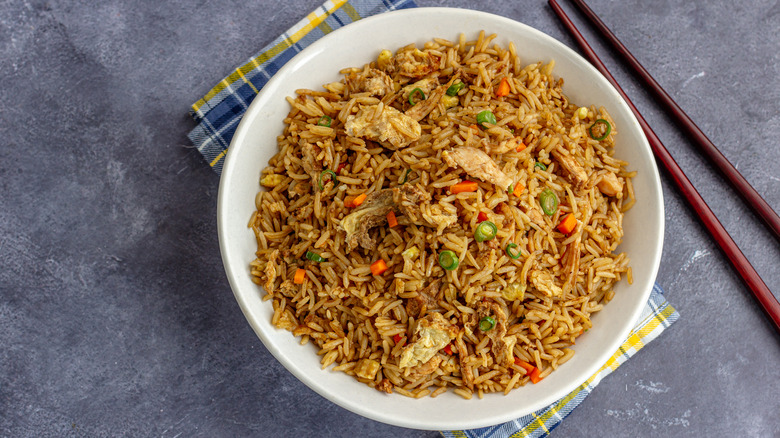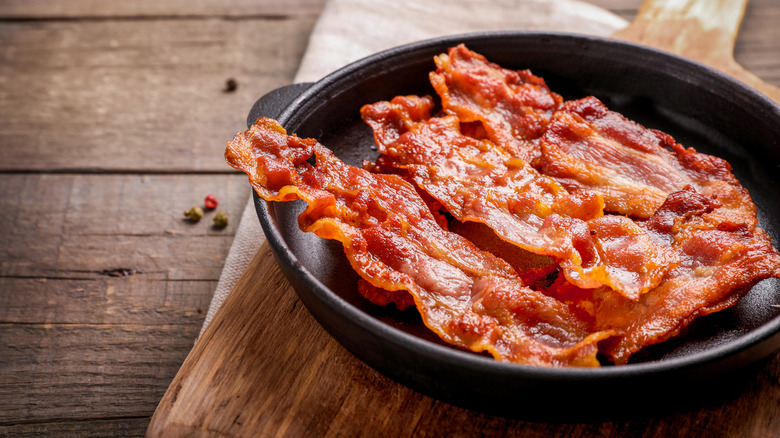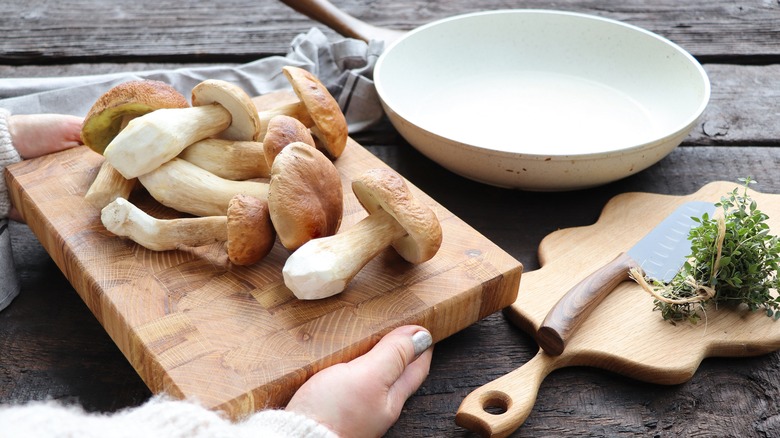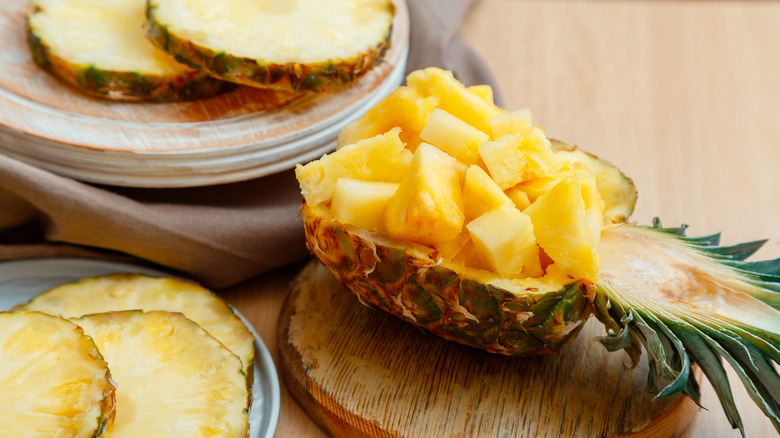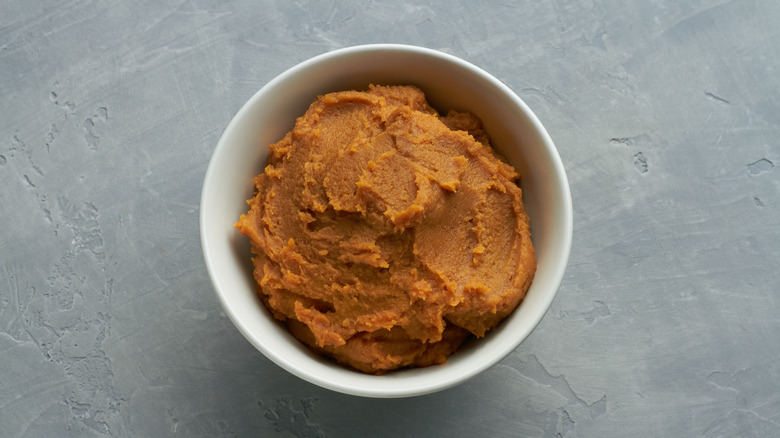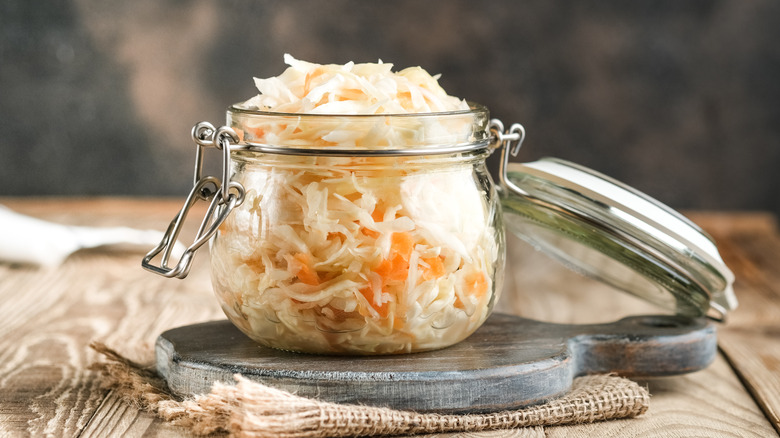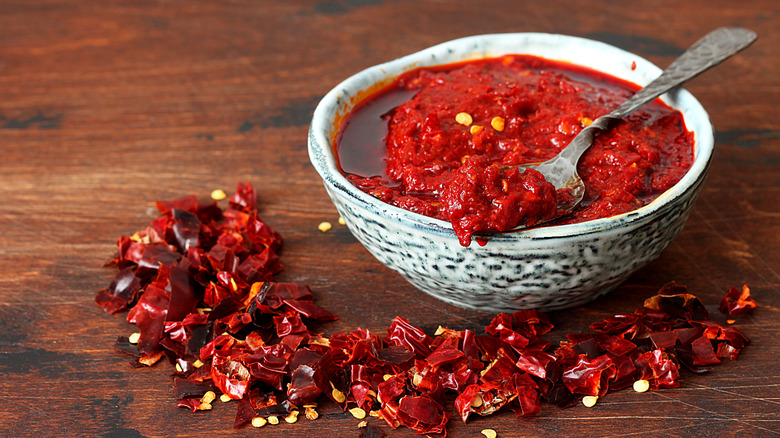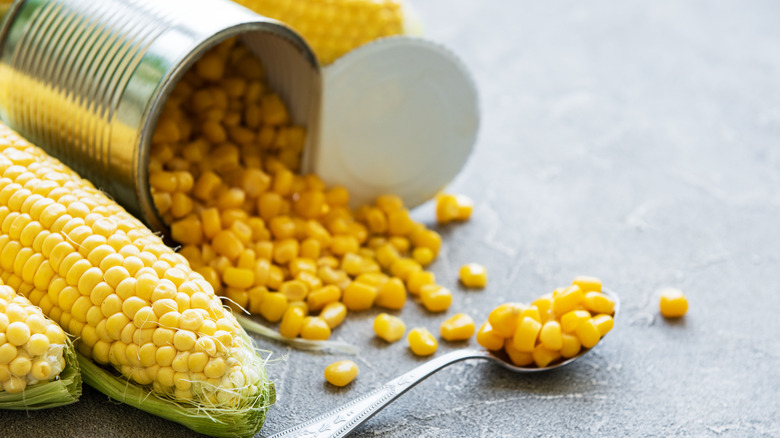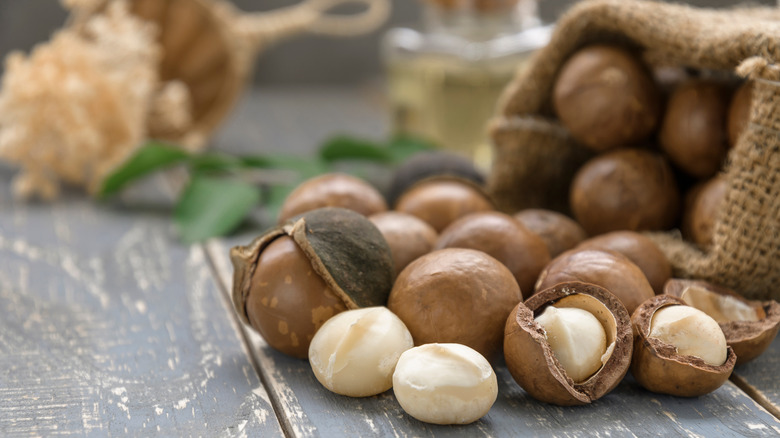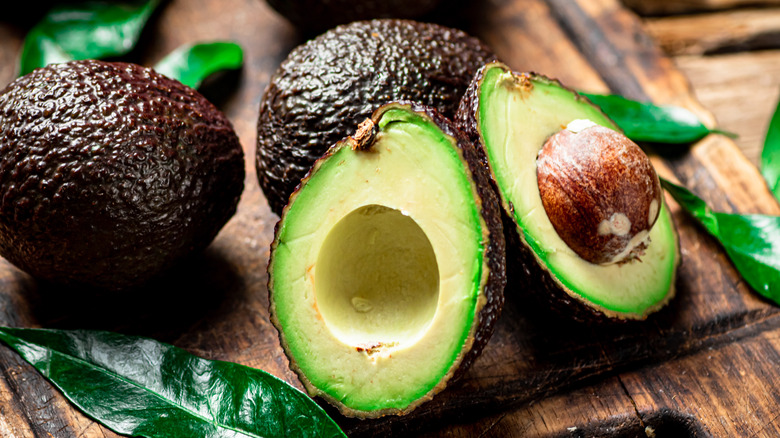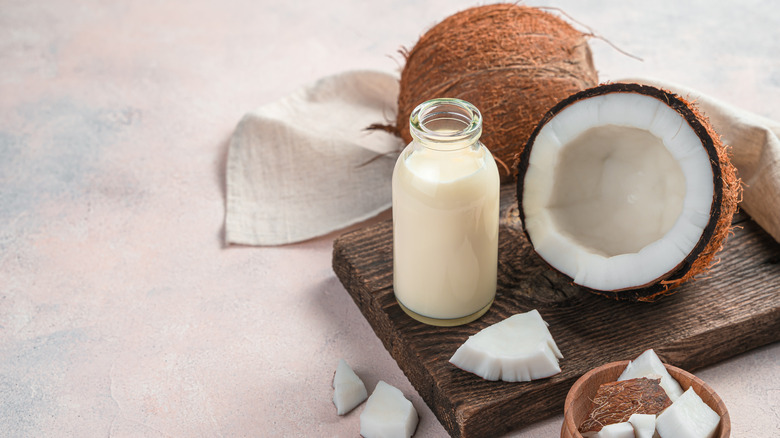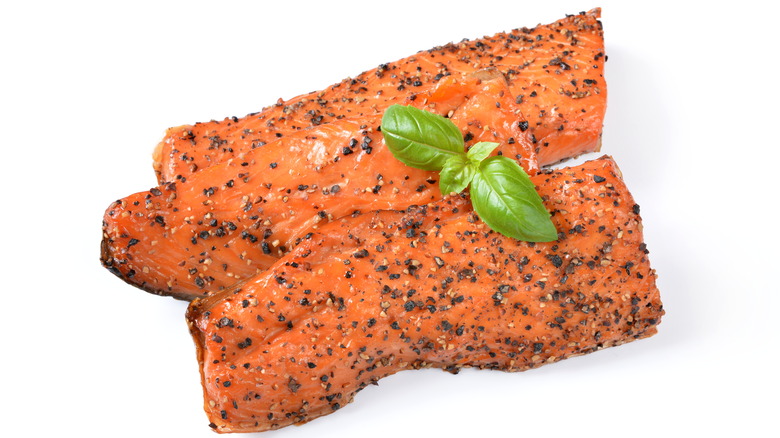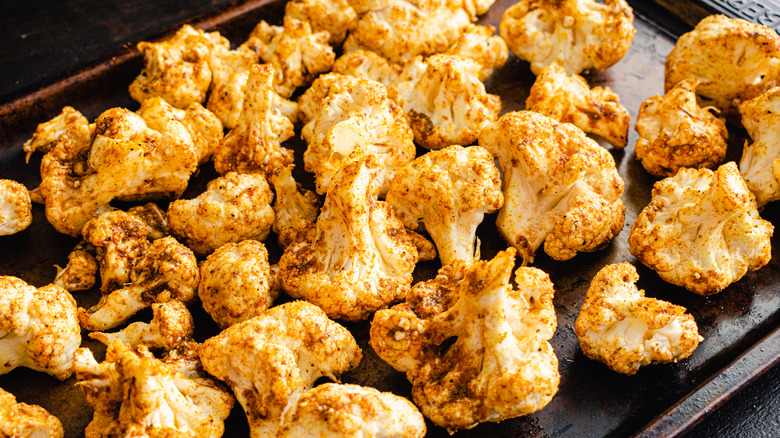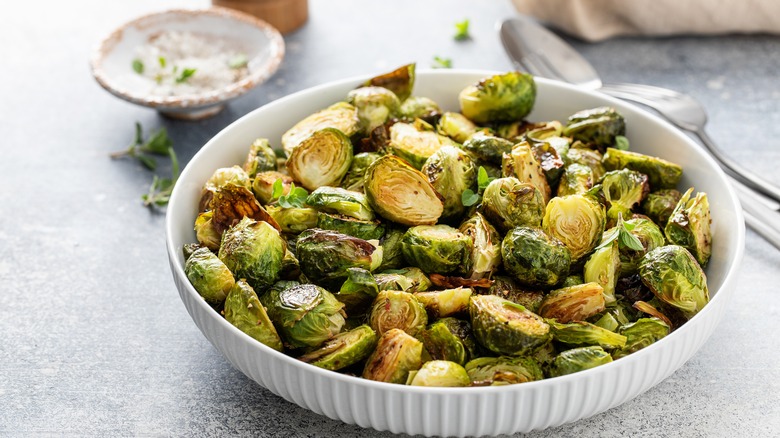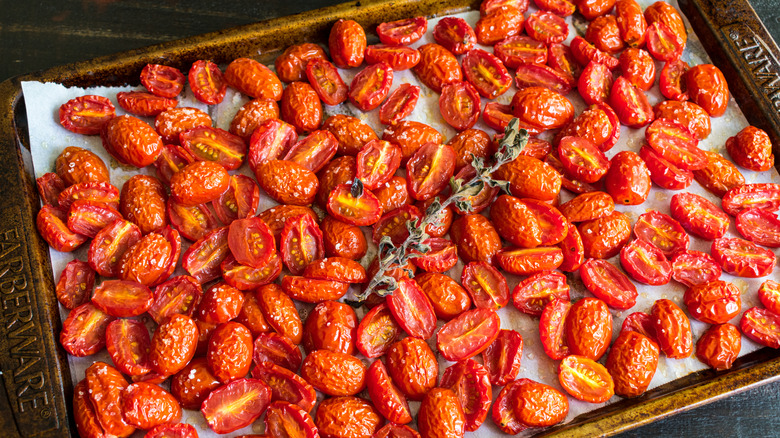17 Underrated Ingredients To Amp Up Your Fried Rice Game
Fried rice was born in Yangzhou, China, located in the Jiangsu province northwest of Shanghai. This region became known as the center of the salt trade in the 3rd century, which encouraged the evolution of a distinct food culture celebrating the "poetry of food." During the Sui Dynasty, emperor Yang popularized the classic iteration of fried rice, which was adopted in the 6th century by peasants to use up leftovers.
While the Chinese typically prefer their rice plain and served alongside various vegetable and meat dishes, for many hard-working peasants, creating a quick meal with whatever happened to be on hand became a necessity. As such, fried rice is not generally served as part of an elegant meal but as part of a meal for the working class. Thanks to the diffusion of Chinese food and culture across the globe, this dish has taken on elements representative of each region it permeated.
In this spirit, one can surmise that the essence of fried rice is one of utility and creativity. It is a tradition that inherently begs the cook to add whatever ingredients one has available or finds comforting. We are looking at the most underrated ingredients you can use in your unique variation of fried rice to elevate it to your version of edible poetry.
Bacon
While the Chinese often incorporate pork into their variations of fried rice, the idea that bacon makes everything better makes its addition to this dish a natural progression. Nothing screams umami flavor like biting into a crispy piece of bacon. Bacon contains the amino acids glutamate and inosinate, which are known to increase saliva production and digestive juices. In essence, bacon makes your mouth water. A little bit goes a long way, promoting satiety and the sense that you are eating more than you may be.
Additionally, because rice is very neutral in flavor, adding something with a salty, savory component to your fried rice is critical. As the rice cooks in the bacon fat, it will absorb the flavor while simultaneously crisping up. And since not all bacon is the same, try playing with different types of bacon. Some cuts of bacon, like slab bacon, are very smoky, while others, like Canadian or Irish bacon, are made from less fatty cuts of the pig, making them meatier and less greasy. If you want to play with flavor, try peppercorn-crusted bacon, hickory smoked bacon, applewood smoked bacon, or maple smoked bacon.
Mushrooms
While mushrooms are common in Asian cuisine, they typically are not added to a classic fried rice recipe. However, there is no reason why they couldn't be for another intense pop of umami flavor. This dish is one of the best places to incorporate rehydrated dried mushrooms, as they are even higher in glutamic acid than fresh mushrooms. To rehydrate dried mushrooms, soak them in hot water for approximately 30 minutes, drain them, slice them, and toss them in the wok. If you like an extra pop of mushroom flavor, reserve some soaking liquid, and strain out any grit through a coffee filter or fine mesh sieve. Once you add the rice toward the end of cooking, you can deglaze the pan with a couple of tablespoons of mushroom juice. The rice will soak up that flavor like a sponge.
And, if you happen to be in an Asian market where you find other types of fresh mushrooms (like shiitake, wood ear, enoki, tea tree, straw, king oyster, shimeji, or maitake), don't be afraid to use them. Just trim the stems, clean thoroughly with a damp cloth or a quick soak, chop, and add them with your other vegetables at the beginning of cooking. Just remember that if you're using freshly rinsed mushrooms, you should dry them thoroughly before adding them to the wok.
Pineapple
While the debate over adding pineapple to pizza continues to rage, adding sweet pineapple to savory fried rice is a no-brainer. This variation of fried rice originated in Thai cuisine, often served inside a hollowed-out half of a pineapple. The juxtaposition of the slightly acidic, sweet pineapple with spicy chilis and salty fish sauce or soy sauce makes this a perfectly harmonious combination.
This is the perfect opportunity to use that can of pineapple that's been sitting in your pantry for way too long. Canned pineapple is both cost effective and often more nutritious than fresh pineapple because it is canned at the apex of its freshness, when the fruit is at its peak nutritional value. Just be sure to look for pineapple canned in water versus syrup, and drain the pineapple of all liquid before using it. We recommend incorporating the pineapple toward the end of the cooking process to prevent it from disintegrating into the dish.
Miso
While miso is traditionally a Japanese ingredient, this fermented soybean paste is delicious and nutritious. Replete with probiotics, this condiment may promote cardiovascular health, balance blood sugars, regulate mood, and aid digestive health. What we love about it, however, is its rich umami flavor profile. As with other fermented soy products, miso is abundant in glutamic acid, giving it a lot of bang for your buck.
When it comes to incorporating it into your fried rice, we recommend substituting other salty components (such as soy sauce, fish sauce, or salt) with a teaspoon or two of miso. Depending upon availability, you may find different types of miso at your local grocer. Miso pastes are divided by color, indicating how long the soybeans have fermented. They equate the pungency to beer, with the youngest and mildest being white miso and the most aggressive being red miso. Try playing with different types until you discover which one you prefer the best.
Sauerkraut
It may be ubiquitous in Eastern European cuisine, but sauerkraut actually originated in China over 2,000 years ago. At the time, fermenting vegetables was born out of a need to prevent them from spoiling. It was only later that researchers discovered how nutritious fermented foods are. Sauerkraut is full of probiotics and antioxidants, which can decrease the risk of some cancers. Like sauerkraut's Korean cousin kimchi, the fermentation process promotes the release of umami-rich compounds.
Incorporating sauerkraut into your fried rice will boost flavor and increase nutrition. Be sure to purchase unpasteurized sauerkraut and drain it well before adding it to your dish to eliminate moisture and excess salinity. And, if you can find them, many brands offer different flavored sauerkrauts. The spicy and garlic infused varieties would be perfect accompaniments to a bowl of classic fried rice. However, avoid the beet-infused ones, as they will make your entire dish purple.
Poached egg
Adding a fried egg atop Asian noodles and rice dishes is common. There is an understanding that egg yolks are a powerful source of umami-loaded glutamates when stirred into practically any dish. As the yolk coats the starch, it develops a cheesy texture and delicious flavor. While a fried egg is good, a poached egg is even better.
There are many ways to poach an egg, but we swear by the classic technique of filling a saucepan about half full with water and adding one tablespoon of apple cider vinegar. Bring the water to a boil and reduce the heat to a simmer. Make sure you use the freshest eggs possible for this process. Carefully crack each egg into a ramekin and slowly pour the eggs one at a time into the simmering water. We typically only poach two eggs at a time to prevent them from sticking to one another and tearing. Using a slotted spoon, check the eggs every 30 seconds or so. Eggs are perfectly poached when their whites have cooked, yet their yolks are still soft. You can transfer the poached eggs to a bowl of warm water until you have poached all the eggs you need. Garnish with toasted sesame seeds and a pinch of smoked sea salt for even more flavor.
Harissa paste
The criminally underrated condiment Harissa originated in Tunisia. Today, harissa appears throughout North Africa, the Mediterranean, and the Middle East. This delicious chili paste typically contains peppers, preserved lemon, garlic, olive oil, salt, pepper, and sometimes cumin or paprika. Different variations include green harissa and can range in spiciness from pretty mild to nice and hot.
What we enjoy most about this chili paste is that it has a complex flavor without being overly spicy. The kind of spiciness that is hot for the sake of being hot can overwhelm other delicate flavors in a dish and render you incapable of tasting anything but the spice. As a garnish atop a bowl of classic fried rice, this condiment, which tends to have a delicate sweetness and slight acidity, pairs beautifully with the salty, umami-forward flavors of soy sauce or fish sauce.
Canned beans
Canned beans are a cost effective, easy, and healthy pantry item to have on hand at all times. They contain fiber, protein, and nutrients, like folate and potassium, all of which contribute to a well-balanced diet. Many people have an assortment of different beans stocked up, but our favorites include chickpeas, cannellini beans, edamame, black-eyed peas, and lima beans. All of these would be perfect additions to a vegetarian fried rice dish.
When using canned beans, we recommend draining and rinsing them before adding them to your recipe to reduce the amount of added sodium. We also suggest adding the beans toward the end of cooking, along with the rice, so they don't get mushy or disintegrate. And if you want to get snazzy, try mixing your beans. Opting for beans with slightly different textures, like chickpeas combined with edamame, will give you a more satisfying mouthfeel and produce a more appealing, colorful end product.
Canned corn
Although domesticated corn originated in Mexico about 9,000 years ago, the grain has since made its way across the globe. In fact, according to Statista, the Chinese now grow more corn annually than rice — not for human consumption, but for animal feed. Yet, adding sweet corn to traditional Chinese foods isn't foreign. Cornstarch is a staple for thickening sauces, and baby corn (predominantly grown in Thailand, Taiwan, and Indonesia) is commonly added to curries, stir-fries, and noodle dishes throughout Asia. These baby corn ears are often hard to come by in the U.S. The next best thing many of us have in our pantries is canned sweet corn, which makes it a natural addition to your homemade fried rice recipe.
Sweet corn canned at the peak of freshness retains much of its nutritional value, including antioxidants, vitamins, and minerals, like the phytochemicals lutein and zeaxanthin, which are associated with the prevention of age-related macular degeneration. To retain most of the flavor and health benefits of canned corn when adding it to your fried rice, drain and rinse your corn to eliminate added sodium from the canning process, and add it toward the end of cooking along with your rice to heat it through. It will retain its slight crunch and bright color while giving your fried rice textural variation.
Macadamia nuts
The use of nuts in Asian cuisines, in general, is quite common. Just think of dishes like Cashew Chicken or a Thai Peanut Curry. Nuts are not only nutritional powerhouses loaded with protein, fiber, unsaturated fats, and omega-3 fatty acids, but they infuse any culinary creation with great flavor and a distinct texture. We often play with different nuts in cooking, like using pistachios instead of pine nuts in a homemade pesto or substituting almonds for walnuts in a loaf of banana bread. When thinking of nuts that would work well in a fried rice dish, the one that kept coming up for us was the macadamia nut.
While macadamia trees are indigenous to Australia, they grow in nations throughout the Pacific region, particularly Hawaii. It's hard to imagine Hawaiian cuisine without the mighty macadamia. Its high-fat content and creamy texture pair beautifully with many other ingredients, chief among them seafood, making them ideal as an addition to shrimp fried rice. Just be sure to toast your macadamia nuts before use to draw their nuttiness out and to give them a crunchier texture.
Avocado
When you think of an avocado, you likely think of Latin culinary traditions. Indeed, the avocado originated in the Puebla region of Mexico, where it has been consumed for over 10,000 years. This fruit has a creamy texture and slightly sweet flavor and is incredibly versatile in its potential uses. Additionally, it is a nutritional powerhouse, loaded with so many vitamins and minerals with potential health benefits that it is almost impossible to believe that one fruit can do so many amazing things.
With that in mind, the primary reason we love adding it to fried rice stems from the classic Latin dish Arroz con Pollo, which has as many variations as there are countries in central and south America. This chicken and rice dish is often served spicy in a similar fashion to a bowl of classic fried rice. One way to tame those spices is to garnish them with fresh, ripe avocado slices. Additionally, because the flavor of the avocado is so mild, it absorbs strong umami-forward condiments, like soy or fish sauce. Try adding it to your next chicken fried rice for a delightful twist.
Coconut milk
Making coconut milk involves combining the flesh of a ripe coconut with boiling water. The combination is subsequently strained through a fine mesh sieve or cheesecloth to produce a thick liquid rich in nutrients. This so-called milk is a great way to thicken sauces without dairy. It is most typically found in Southeast Asian culinary traditions, although it is also common in Hawaii, India, parts of South America, and the Caribbean.
Coconut milk is an incredibly versatile ingredient to add to sweet and savory dishes. Because of its viscosity and slightly sweet undertone, it is amenable to spicy dishes, helping to cut through the spice and spread it across your tongue for a more nuanced mouthfeel. For this reason, we love adding it to a fried rice dish loaded with spices and perhaps a sweet component, like pineapple. You can purchase coconut milk in a can or carton. It also comes in light and full-fat versions. We recommend using the full-fat version, and we typically opt for the canned brands — they tend to have a smoother texture. However, just remember that they require a bit of stirring to recombine the water with the coconut.
Smoked salmon
The addition of fish to fried rice isn't a novelty. Seafood is an integral part of the Chinese diet thanks to its availability and nutritional value. And while many cultures are known for their use of smoking fish as a method of preservation, the Chinese have a long legacy of producing tea-smoked fish. This technique originated in the Sichuan region of China and has spread throughout the country with varying smoking techniques and ingredients.
Unless you plan to make a smoker and smoke your fish, meat, or eggs using a traditional Chinese technique, you will likely need to purchase commercially available smoked meats. Our favorite type of smoked fish to add to a fried rice recipe is smoked salmon. While some confuse smoked salmon with lox, which is cold-cured, we prefer the real deal for its intense umami-rich flavor and flaky texture. It is salty, so when you add it to fried rice, we recommend lowering the use of other salty components, like soy sauce, to keep the dish from being too salty.
Cauliflower
Cauliflower is one of the top ten vegetables consumed in China. Known as the "flower of vegetables," cauliflower originated in the region that is now modern-day Turkey. From there, it proliferated throughout the Mediterranean and Europe, making its way through Asia to China. While the Chinese typically consume it in stir-fries either as an accompaniment to meat or a substitution for meat, you can add it to virtually any dish, including fried rice.
Because of its inherent nutty flavor, cauliflower contributes a delightful complexity to your dish, along with a hint of crunch. While cauliflower rice is all the rage right now as a low-carb substitute for rice, this is by no means what we mean by incorporating cauliflower into your fried rice. Use it in addition to rice alongside any other vegetables and meat you may like. Additionally, if you'd like to add an even more robust umami profile, consider coating your cauliflower with a hint of sesame oil and smoked sea salt before roasting it in the oven and adding it to your fried rice. That extra step will caramelize the natural sugars in the cauliflower while taming some of the characteristic cabbage-like aromas that cooked cauliflower can have.
Brussels sprouts
The likely offshoots of Mediterranean kale, brussels sprouts are native to Brussels, Belgium, as their name suggests. These little members of the Brassicaceae vegetable family share many of the same nutritional benefits as their cousins, like broccoli or cabbages of all types. They can also be similarly challenging to digest raw due to their high fiber content. Yet they are a natural addition to Chinese dishes, like fried rice, as various cabbages, including bok choy, are commonly incorporated into Chinese stir-fries.
There are two ways to add brussels sprouts to fried rice. If you want to cook them along with other vegetables at the beginning of the process, we recommend shredding them so that they cook thoroughly, which you can do using a food processor. Alternately, consider cutting them in half and roasting them tossed in plenty of oil before adding them to your fried rice. This process will ensure they are tender and improve their flavor by caramelizing the natural sugars in the sprouts, eliminating any potential bitterness they may have.
Freshly grated parmesan cheese
We know what you are thinking: "Italian cheese added to a Chinese rice dish? That sounds crazy." Maybe. But if you think about a classic risotto dish as the Italian version of Chinese fried rice, the idea makes more sense. In many ways, risotto is as flexible as fried rice is. You can add almost any ingredient to make it unique. Combining the deep umami-dense flavors present in an aged parmesan to the creaminess of arborio rice works so well. These umami flavors could pump up the excitement of your fried rice, too.
Make sure to use real parmesan cheese instead of the pre-grated stuff in the green jar, and it is best to add it right at the end of cooking. One final note: There has long been a taboo about adding cheese to anything with fish or seafood. While this isn't universally supported, in the case of not overpowering the flavors in your fried rice, we recommend steering away from fish sauces or seafood if you intend to garnish your fried rice with parmesan cheese. As such, this may be a garnish best reserved for a vegetarian version of this dish.
Tomatoes
Tomatoes are one of the most umami-forward foods out there. The key to their prolific umami-ness is that they are high in glutamic acid. When they are roasted or dried, their glutamic acid content increases, making them an ideal addition to fried rice. They are also highly nutritious and one of the few vegetables (or fruits, depending on who you ask) that become healthier when cooked, thanks to the increased accessibility of lycopene in cooked tomatoes.
When using fresh tomatoes, add them at the beginning of cooking your fried rice to ensure all the liquid from the tomato evaporates. If you opt to use sun-dried tomatoes, consider purchasing ones marinated in oil, as some vitamins in tomatoes are fat-soluble, increasing their absorption. However, given the availability of fresh, ripe tomatoes in the summer, we recommend roasting them yourself. After roasting, peel, chop, and add them to your meat and vegetables before adding the rice to your next fried rice masterpiece.
Static Media owns and operates Daily Meal and Tasting Table.
